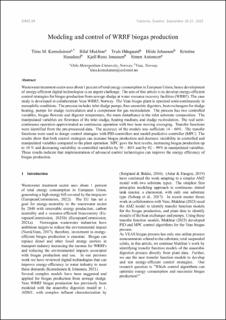| dc.contributor.author | Komulainen, Tiina | |
| dc.contributor.author | Mukhtar, Bilal | |
| dc.contributor.author | Ødegaard, Truls | |
| dc.contributor.author | Johansen, Hilde | |
| dc.contributor.author | Haualand, Kristine | |
| dc.contributor.author | Jonassen, Kjell Rune | |
| dc.contributor.author | Antonsen, Simen | |
| dc.date.accessioned | 2023-11-14T08:27:39Z | |
| dc.date.available | 2023-11-14T08:27:39Z | |
| dc.date.created | 2023-10-20T09:16:10Z | |
| dc.date.issued | 2023 | |
| dc.identifier.issn | 1650-3686 | |
| dc.identifier.uri | https://hdl.handle.net/11250/3102311 | |
| dc.description.abstract | Wastewater treatment sector uses about 1 percent of total energy consumption in European Union, hence development
of energy-efficient digital technologies is an urgent challenge. The aim of this article is to develop energy-efficient
control strategies for biogas production from sewage sludge at water resource recovery facilities (WRRF). The case
study is developed in collaboration Veas WRRF, Norway. The Veas biogas plant is operated semi-continuously in
mesophilic conditions. The process includes inlet sludge pumps, four anaerobic digesters, heat exchangers for sludge
heating, pumps for sludge recirculation and a compressor for gas recirculation. The process has two controlled
variables, biogas flowrate and digester temperature, the main disturbance is the inlet substrate composition. The
manipulated variables are flowrates of the inlet sludge, heating medium, and sludge recirculation. The real semi-
continuous operation approximated as continuous operation with two hour moving averaging. Transfer functions
were identified from the pre-processed data. The accuracy of the models was sufficient 14 − 60%. The transfer
functions were used to design control strategies with PID-controllers and model predictive controller (MPC). The
results show that both control strategies can increase biogas production and decrease variability in controlled and
manipulated variables compared to the plant operation. MPC gave the best results, increasing biogas production up
to 10 % and decreasing variability in controlled variables by 50 − 80% and by 92 − 99% in manipulated variables.
These results indicate that implementation of advanced control technologies can improve the energy efficiency of
biogas production. | en_US |
| dc.language.iso | eng | en_US |
| dc.relation.uri | https://doi.org/10.3384/ecp200027 | |
| dc.rights | Navngivelse 4.0 Internasjonal | * |
| dc.rights.uri | http://creativecommons.org/licenses/by/4.0/deed.no | * |
| dc.subject | Reguleringsteknikk | en_US |
| dc.subject | Control technology | en_US |
| dc.subject | Prosessmodellering | en_US |
| dc.subject | Process modeling | en_US |
| dc.subject | Numerisk simulering | en_US |
| dc.subject | Computational Fluid Dynamics | en_US |
| dc.title | Modeling and control of WRRF biogas production | en_US |
| dc.type | Peer reviewed | en_US |
| dc.type | Journal article | en_US |
| dc.description.version | submittedVersion | en_US |
| cristin.ispublished | true | |
| cristin.fulltext | preprint | |
| cristin.qualitycode | 1 | |
| dc.identifier.doi | 10.3384/ecp200027 | |
| dc.identifier.cristin | 2186601 | |
| dc.source.journal | Linköping Electronic Conference Proceedings | en_US |
| dc.subject.nsi | VDP::Andre elektrotekniske fag: 549 | en_US |
| dc.subject.nsi | VDP::Other electrotechnical sciences: 549 | en_US |

